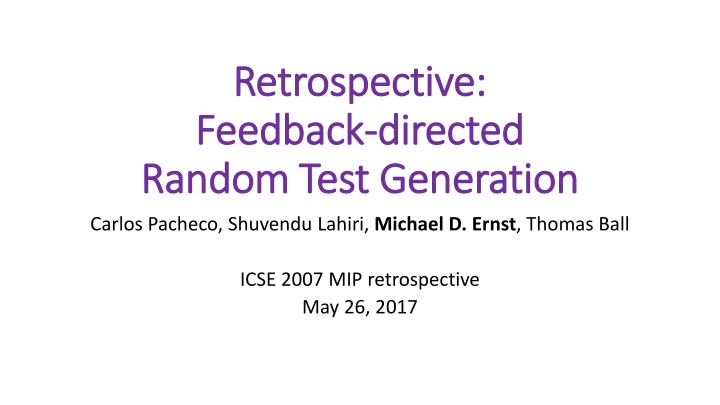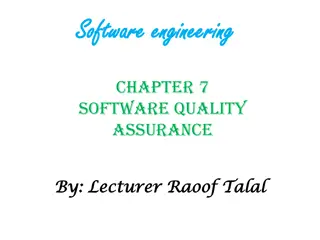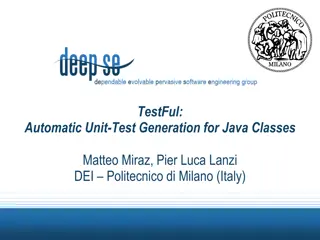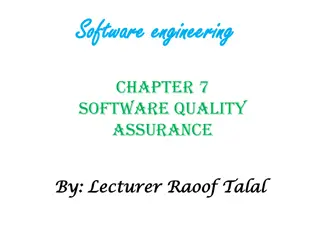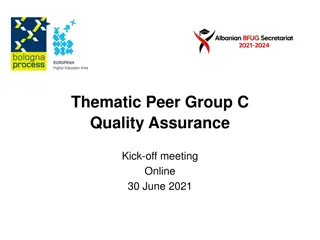Automated Test Generation for Software Quality Assurance
In the software development field, automated test generation tools play a crucial role in ensuring code quality by automatically creating tests to verify the behavior of programs. This article discusses the importance of test generation, challenges faced in classifying tests, and how tools like Randoop aid in creating effective tests. It also highlights the significance of oracles, the types of tests generated, and the impact on bug discovery. Understanding these concepts is essential for maintaining high-quality software products.
Download Presentation

Please find below an Image/Link to download the presentation.
The content on the website is provided AS IS for your information and personal use only. It may not be sold, licensed, or shared on other websites without obtaining consent from the author.If you encounter any issues during the download, it is possible that the publisher has removed the file from their server.
You are allowed to download the files provided on this website for personal or commercial use, subject to the condition that they are used lawfully. All files are the property of their respective owners.
The content on the website is provided AS IS for your information and personal use only. It may not be sold, licensed, or shared on other websites without obtaining consent from the author.
E N D
Presentation Transcript
Retrospective: Retrospective: Feedback Feedback- -directed Random Test Generation Random Test Generation directed Carlos Pacheco, Shuvendu Lahiri, Michael D. Ernst, Thomas Ball ICSE 2007 MIP retrospective May 26, 2017
Who loves to write tests? Who loves to write tests? Problem: Developers do not love to write tests There are not enough tests Solution: Automatically generate tests Randoop tool https://randoop.github.io/randoop/
What is a test? What is a test? A test consists of an input an oracle End-to-end test: Batch program: input = file, oracle = expected file Interactive program: input = UI events, oracle = windows Unit test: Input = sequence of calls Oracle = assert statement
Example unit test Example unit test Object[] a = new Object[]; LinkedList ll = new LinkedList(); ll.addFirst(a); TreeSet ts = new TreeSet(ll); Set u = Collections.unmodifiableSet(ts); input assert u.equals(u); oracle Assertion fails: bug in JDK!
Automatically generated test Automatically generated test Code under test: public class FilterIterator implements Iterator { public FilterIterator(Iterator i, Predicate p) { } public Object next() { } } * the iterator or predicate are null */ /** @throws NullPointerException if either Automatically generated test: public void test() { FilterIterator i = new FilterIterator(null, null); i.next(); } Did the tool discover a bug? It could be: 1. Expected behavior 2. Illegal input 3. Implementation bug Throws NullPointerException! Test classification problem
Challenge: classifying tests Challenge: classifying tests Without a specification, the tool guesses whether a given behavior is correct False positives: report a failing test that was due to illegal inputs False negatives: fail to report a failing test because it might have been due to illegal inputs Test classification is useful for: Oracles: A test generation tool outputs: Failing tests indicates a program bug Passing tests useful for regression testing Inputs: A test generation tool creates input incrementally Should only build on good tests
Previously created Example unit test Example unit test Object[] a = new Object[]; LinkedList ll = new LinkedList(); ll.addFirst(a); TreeSet ts = new TreeSet(ll); Set u = Collections.unmodifiableSet(ts); input assert u.equals(u); oracle
Pitfalls when extending a test input Pitfalls when extending a test input 3. Useful test Date d = new Date(2017, 5, 26); assert d.equals(d); 1. Useful test Set s = new HashSet(); s.add( hi ); assert s.equals(s); 4. Illegal test Date d = new Date(2017, 5, 26); d.setMonth(-1); // pre: argument >= 0 assert d.equals(d); 2. Redundant test Set t = new HashSet(); s.add( hi ); s.isEmpty(); assert s.equals(s); 5. Illegal test Date d = new Date(2017, 5, 26); d.setMonth(-1); d.setDay(5); assert d.equals(d); do not output do not even create
Feedback Feedback- -directed test generation directed test generation Eclat: Automatic generation and classification of test inputs , by Carlos Pacheco and Michael D. Ernst. ECOOP 2005. model correct execution Specification inference model generator illegal inputs reduced fault rev. inputs fault rev. inputs oracle generator reducer classifier normal inputs Test case selection candidate inputs test cases input generator Feedback-directed test generation
Classifying test behavior Classifying test behavior Satisfies precondition? Yes Yes No No Satisfies postcondition? Yes No Yes No Classification Normal Fault Normal (new*) Illegal * For Eclat: outside the domain of existing tests; feedback to test generator For Randoop: outside the domain of the specification
Test input generator (no oracle yet) Test input generator (no oracle yet) 1. pool := a set of primitives (null, 0, 1, etc.) 2. do N times: 2.1. create new inputs by calling methods/constructors using pool values as arguments 2.2. run the input 2.3. classify inputs 2.3.1. throw away illegal inputs 2.3.2. save away fault inputs 2.3.3. add normal inputs to the pool Null, 0, 1, 2, 3 Stack var1 = new Stack(); Stack var2 = new Stack(3); var1.pop(); var1.isMember(2); var2.push(1);
Implementations: 1. Eclat 2. Joe 3. Randoop.NET 4. Randoop for Java (dozens of releases) Randoop vs. Eclat Randoop vs. Eclat Test inputs: Randoop: dozens of enhancements: richer search space, prune redundancies, Oracles (specifications, assertions): Eclat: generates Randoop: hard-coded library specifications Tool output: Eclat: error-revealing tests Randoop: error-revealing tests and regression tests Evaluation: Eclat: precision of oracles; code coverage; a few errors revealed Randoop: many errors in real-world programs; outperforms existing techniques
Feedback Feedback- -directed Random Test Generation directed Random Test Generation Feedback-directed Random
Random testing: Obviously a bad idea Random testing: Obviously a bad idea No guarantees about fault detection, coverage Systematic techniques give no guarantees Cannot cover simple code Only 1 in 264 chance to find the crash in: void foo(long x) { if (x == 0xBADC0DE) crash(); } Random black-box Many publications show it is inferior [Ferguson 1996, Marinov 2003, Visser 2006, ] Small benchmarks, wrong measurements, strawman implementations Not complex enough to merit publication Say stochastic instead of random
Arguments in favor of random testing Arguments in favor of random testing Simple to implement Fast: generate lots of tests, big tests, many behaviors Scalable: works on real programs In theory, about as effective as systematic testing [Duran 1984, Hamlet 1990] In practice, highly effective Randoop chose random because it was the most practical choice I would choose random again today Feedback-directed unit test generation for C/C++ using concolic execution [Garg 2013]
Other/better test generation approaches Other/better test generation approaches Manual test generators: QuickCheck [Claessen 2000] Exhausive (model checking): Korat [Boyapati 2002] Concolic (concrete + symbolic): DART [Godefroid 2005], CUTE [Sen 2005] Symbolic (constraint solving): Klee [Cadar 2008] Satisfy input constraints: Csmith [Eide 2008] Input similarity metric: ARTOO [Ciupa 2008] Search-based: Genetic algorithms EvoSuite [Fraser 2011], MaJiCKe [Jia 2015] Better guidance: GRT [Ma 2015]
Randoop evaluation Randoop evaluation Found errors in test program used by 3 previous papers Better coverage than systematic techniques on programs they chose for evaluation > 200 distinct defects in .NET framework and JDK Other tools did not scale to this code (Shuvendu will discuss the evaluation further.)
What Randoop is bad at What Randoop is bad at Entire programs (some progress: [Robinson 2011]) Requires tuning Tends to get stuck Complex, specific inputs Protocols -- make calls in specific order (e.g., database connections) Strings Complex objects Tests can be hard to understand Focused generation: Top-down vs. bottom-up generation Still outperforms other techniques and tools.
Perspective Perspective Why was Randoop successful? Advice about your research
How to evaluate a technique How to evaluate a technique Your technique is probably better, but show it honestly Scientific goal is to evaluate techniques, not tools Implement every optimization or heuristic for all techniques Avoids confounding factors Enables fair comparison of systematic, symbolic, and random search Evaluate the optimization or heuristic in multiple contexts Random approaches are a common whipping boy or strawman It is no surprise and no achievement to beat a dumb implementation
When evaluating an existing tool When evaluating an existing tool Don't misuse the tool Example: tune one tool or provide it extra information Read the manual (Randoop manual offers specific advice) Use command-line options (Randoop has 57!) Report bugs
Scientific progress requires reproducibility Scientific progress requires reproducibility Make your work publicly available tool, evaluation scripts & inputs, and outputs Extra effort: robust and easy to use, beyond the experiments in the paper Some people choose to prioritize other factors Money, reputation, scientific advantage, number of publications If you prioritize other factors and keep your data secret, you are not fully acting like a scientist "If I have seen further, it is by standing on the shoulders of giants. Isaac Newton, 1676.
Maintain your artifacts Maintain your artifacts Other people can compare to, and build on the work Other people can disparage the work or scoop you Distracts from other research 10 years later, I still maintain Randoop Bug fixes, new features On average, 1 release per month (version 4 next month) Against the advice of some faculty Essential for scientific progress Poorly rewarded by the scientific community Pursuing the shiny new thing Valuing novelty over effectiveness Valuing number of papers over scientific value and impact
Dont give up Don t give up My papers were rejected before being accepted and became better as a result A paper rejection is a gift Eclat paper had limited impact ICSE 2007 recognized the value of my work! ACM Distinguished Paper Award Time (and more work!) can change people s opinions about what has most impact
We need We need results results, not ideas , not ideas Arguments in favor of results: Most ideas are worthless It s easy to make up a persuasive argument If you aren t willing to do the work, do you believe in your idea? Poor evaluation may be misleading Idea papers reward shallow work, inhibit subsequent publication Arguments in favor of ideas: An imaginative contribution Shows connections between areas Sparks yet more ideas Proposes work for other people to do Recognition on CV Your work should be actionable
Implement your idea Implement your idea Enables evaluation Essential for understanding the technique Essential for evaluating the technique Essential for evaluating usefulness Always yields surprises (ABB for detouring, Microsoft for discarded tests, ) Helps the whole field Others can build on it Others are inspired to do better Enables comparisons
Evaluation: the most important part of a paper Evaluation: the most important part of a paper Don t just show success, show improvement Requires comparison to previous techniques Requires that previous tools exist or are re-implemented Evaluate the whole task, not just part of it Misleading to claim big improvement on a trivial part of the problem Measure the right metrics For testing, not coverage or mutant kill score Use real defects, such as Defects4J [Just 2014] or CoREBench [Boehme 2014] Involve the user Case studies can be more appropriate than controlled experiments Gold standard: real-world use What are the most important aspects to be realistic? Won t realistic evaluations slow down science? Science is about truth and results, not ideas or publications
Test generation: quality over quantity Test generation: quality over quantity It s easy to produce a lot of tests Previous work (Jov, Jcrasher) produced mostly illegal tests Example: illegal inputs lead to crashes We examined the tests: what would a user do? Randoop was willing to discard some tests Quality metric: reveal real defects Count defects, not failures. Don't be discouraged if the maintainers won't fix them.
Ideas: quality over quantity Ideas: quality over quantity Aimed for simple ideas, concisely explained Easy to understand, reproduce, refute The best papers have simple ideas Simple ideas are harder to produce than complex ones
Automation: quality over quantity Automation: quality over quantity Human is expected to Examine failures Provide input/guidance to Randoop Cooperation between human and machine Each does the tasks it is best suited to
Publications: quality over quantity Publications: quality over quantity Only 3 Randoop publications Despite 15 years of work
Randoop is still finding bugs Randoop is still finding bugs This month, 60 bugs in Apache Commons Math (and many others) Randoop remains the easiest to use and best test generator There's no good reason not to run Randoop on your program Try it today: C#: https://github.com/abb-iss/Randoop.NET Java: https://randoop.github.io/randoop/
